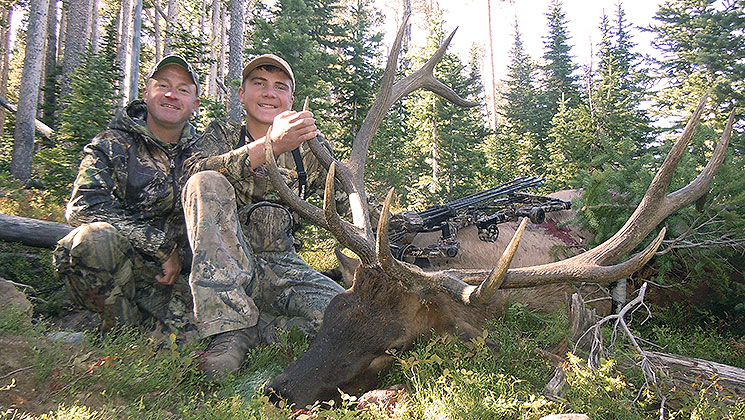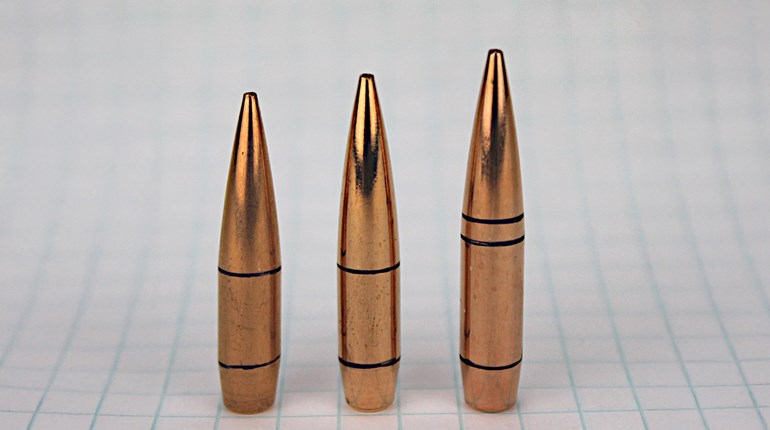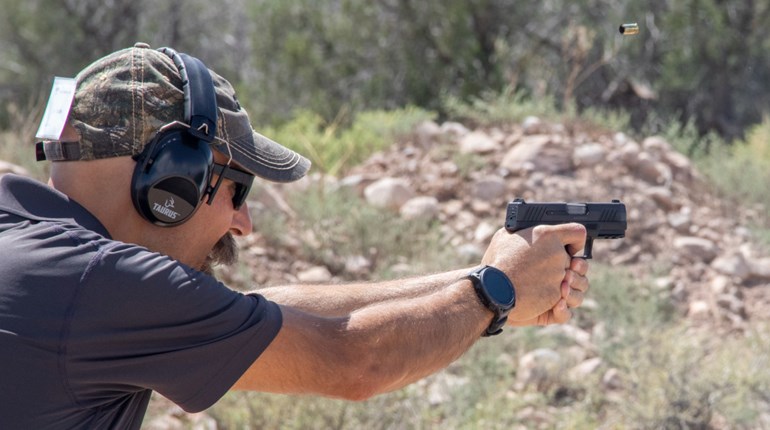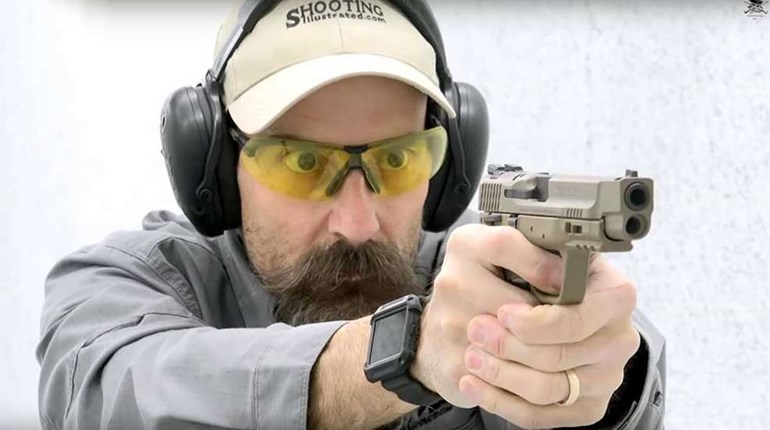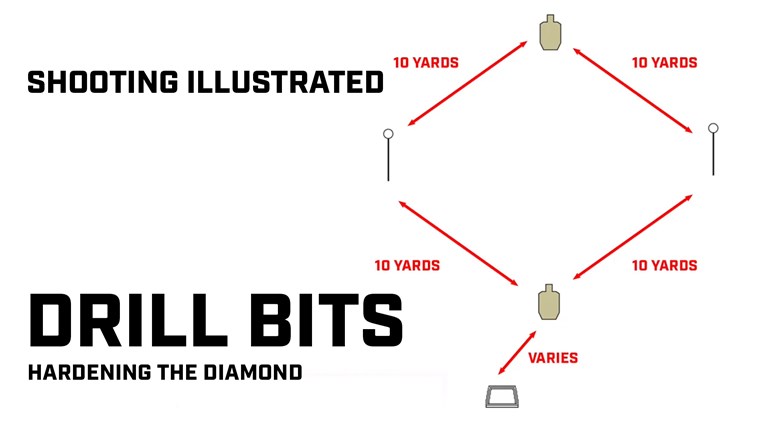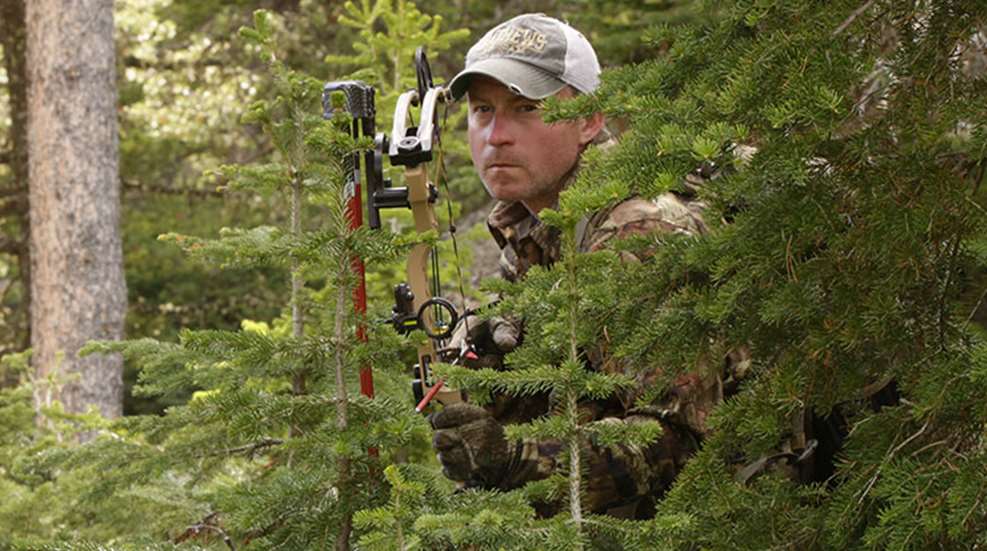
Options were beginning to disappear like life vests on the ill-fated Titanic as I thrashed a stout timber against a lodgepole pine for the umpteenth time. The ploy was to mimic the actions an assertive bull makes in the heat of the rut. It created yet another bugle response, but the bull was as cemented as the feet of a double-crossing mobster prior to an eternal splash. Desperation tactics were now on the table after nearly 20 minutes of continuous calling. Whistling to catch the attention of my son, Cole, I used hand signals to signify a regroup from our split position of nearly 60 yards.
“He won’t budge, but he bugles at everything I throw at him,” I whispered in a hushed tone as we met up. “Since he won’t move we will. Let’s run down this hill to the creek below. I’ll call and make him think the herd is leaving with or without him.”
Cole nodded and we started jogging down the hill with no intentions of being quiet. The plan was to sound like a herd of elk, and I tossed in a couple of mews to complete the illusion. Halfway down the slope the bull bugled again, but this time it sounded like it came from a new location. Had his cement shoes suddenly broken free?
The timeframe for this hunt was early September, just prior to when cows were on the calendar for their annual estrus. The bull’s public-land paranoia was functioning well and likely the reason for the stonewalling, but the bugles indicated he was piqued about the possibility of being party to a breeding frenzy if indeed the rut ruckus was valid. Meeting September situations like this with a committed response may land you a front row seat to one of nature’s greatest shows: a face-to-face meeting with a bugling bull elk. To make your response options easier, break down September into three distinct periods and put one of these power plays to work for you.
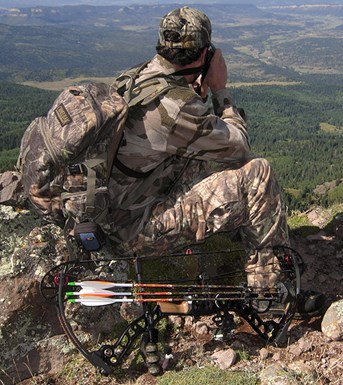 Get a Nosebleed
Get a Nosebleed
Do you have a nosebleed? Good. You’re now hunting in early-season elk country. Sure, elk can be found at low elevation, but guess what? In most instances low elevation equals private land, and those gates usually don’t open without a family connection or Ben Franklins in hand. Whether you hold a bow tag or a premium early-season rifle tag, altitude may be your savior.
“Do you mind hunting the high country?” Randy Slaughter of Banded Peak Ranch Outfitters asked me. “I think with the heat we’re experiencing down low your best bet is to stay high where it’s cool and the elk might be more active.”
I agreed, and last season I spent most of my early-season Colorado hunt at elevations above 10,000 feet. It just makes sense to plan any early-season hunt at the highest elevations in a particular hunting unit. Here’s why:
First, elk favor the high country for the surge of nutritious, alpine grasses. This lush carpet greens daily as snow recedes and summer temperatures creep up the slope. This provides elk with a dining option that continues until decreasing daylight in the fall shuts down growth potential. Elk summer in the high country, and that’s where you’ll generally discover large herds before they transition to fall patterns.
Second, vertical slopes provide safety to herds of elk. Open, alpine terrain gives elk the ability to scan for danger, plus it slows down predators, giving elk an edge in case a fleeting escape is required.
Finally, elk move to higher elevation for the previously noted “cool” factor. On average, temperatures drop three to four degrees for every 1,000 feet of elevation. That occurs because of decreasing atmospheric pressure at higher elevations, resulting in cooler air. This keeps insects at bay, but also makes elk feel frisky longer in the mornings and earlier in the afternoons as thermals direct cool air up, and down the mountain. Elevated elk could be more active earlier in the rut than at a lower elevation.
Slaughter’s suggestion was spot-on. Based on camp comparisons, hunters homing in at high elevation were twice as likely to be in bugling bulls during the first days of Colorado’s season. My campmate, Corrine Bundy with Mathews Archery, found out firsthand on the first day of her hunt. At 10,000 feet, mid-morning, a lone bull returned bugles to her guide’s growling calls and then cooperatively walked straight to her position. A 17-yard shot ended her hunt on Sept. 1, hardly a time period known for great calling.
Scream Like You’re At a One Direction Concert
Prior to mid-September, bulls are on edge waiting for the first cow to hit estrus. Make it sound like they’ve found that first cow. Create the atmosphere of an elk concert.
That’s how 30-year veteran Colorado elk guide Travis Shippey handles reluctant bulls prior to the estrus explosion. Shippey’s humble answer, “I really don’t have a set plan,” may be truthful in his mind, but his mental gears are turning when bulls answer his calls. In reality, his plan is as fluid as synthetic oil and revs up the motor of elk, especially those that may not be in a rambunctious mood. In brief, Shippey’s not afraid to get mileage out of his calls.
“My goal is to fire them up if at all possible,” he says. “You’re going to scare some off, I can promise you that, but when you only have a five- or six-day window to hunt, you just move on to the next one.”
Careful not to promote a strategy of never-ending calling, Shippey instead lays out a blueprint to find the right bull. He’s shared the woods with public-land hunters and has heard the nonstop chorus of hunters bugling from ridgetops. Although the band-rehearsal approach might work, too much stimuli can shut down elk. Instead of racing through the woods with calls blaring, he takes on the approach of a northland walleye angler trolling a variety of baits. Once he finds a willing bull interested in the bait, he’ll start the concert.
He begins most inquiries with a cow call to test the woodland waters. If that doesn’t ignite a return response he may chuckle or even bugle. Years of hunting have taught him that elk, like people, respond to different stimuli depending on personality and mood. Once he gets a response his next step is to feed the bull more of the same, but ramp it up quickly.
“I’ve watched lots of hunters on TV. In my opinion most are not aggressive enough. It’s weak, and I believe the elk lose interest fast. I want to tick that dude off and make him think there are cows mingling with aggravated bulls. That’s what makes another bull come on down to check it out.”
By creating the atmosphere of a herd engaged in rutting unruliness, Shippey works toward luring outside bulls into the mayhem.
“Loud, aggressive bugling combined with chuckles and grunts, and spaced between five or six cow calls, makes it sound like a bull is there with lots of cows. It aggravates bulls that are listening and fuels their rage further. I’ll rake trees, break limbs and even toss rocks. Elk make a lot of noise, and if you’re too quiet it might scare them more than lure them.”
That’s exactly what Shippey did for me on a recent Colorado archery hunt. Not once, but three times he called the same bull into bow range by making it sound like a herd was riled and rutting. Each time the bull would race in looking for the noisemakers and then circle ahead in an attempt to catch up with the illusionary herd. Unfortunately, I just couldn’t manage a shot in the thick timber.
On the third attempt the bull caught us in mid-stalk, but that didn’t stop Shippey. I stood statue-still as Shippey turned to direct the calls away from our location. With Garmin precision, the bull walked straight to where Shippey sent the bugle and passed inside of 40 yards—the perfect distance for my Mathews Creed XS to do its job.
Be a Stalker
You may be hearing more elk bugles than you can count once the cows begin cycling into estrus during the last half of September, but that doesn’t mean a big bull will run to your calls. When cows come into season it can be downright difficult, if not impossible, to call in mature bulls. Estrus cows and insistent satellites keep herd bulls busy. Now is the time to be a stalker.
For Wyoming outfitter Ross Adney, owner of Beaver Trap Outfitters it’s the one time during hunting season when he occasionally sneaks in a few days to hunt for himself. Not having a client in tow doesn’t make it any easier, though, as Adney explains.
“At that time of the year bulls have been called to enough. They know what a human bugle sounds like, plus herds are established and bulls are focused on hot cows within the herd. Stalking or shadowing a herd at this time makes sense.”
Adney doesn’t promote a calling strategy because he knows the herds will already be giving away their location with fired-up bull chatter for estrus cows, especially as breeding opportunities dwindle. That noted, he does use long-distance bugles to find elk, and when immersed in a herd a well-timed bugle can spark the herd bull into an instant showing. More than not you’ll find him in tow behind a herd as he waits for enough chaos for cover.
“Last season I’d been following a herd in my socks to stay quiet,” Adney recalls. “One second the elk were at 80 yards and the next I had two 6-point bulls of equal size bearing down on me as they tried to run each other off. They had no idea I was there. I ended up going for the easy shot and finished my season with a 10-yard bow-kill simply by following along.”
Being quiet by losing his boots and choosing clothes that don’t swish are critical to Adney’s shadow approach to late-September bulls. In fact, the last three bulls he shot with his bow were done in stocking feet and with minimal calling. Adney also has an arrow nocked whenever he’s within sight of elk as the moment may arrive unexpectedly, like with the battling bulls. However, he does stress safety when walking with a nocked arrow. Moving quickly when conditions demand is another of Adney’s success factors.
“Don’t be afraid to move fast,” he says. “Elk can get away from you in a hurry when they are running those cows hard. And even if you bump them, don’t give up, especially if they continue to bugle. Four years ago I slipped in close to a big bull that was being harassed by a raghorn. I know that bull saw me at least three different times as I moved to get a shot, but he still kept bugling. Three different times I got to full draw on the bull, but I just couldn’t get the perfect shot. Still, he knew I was there all along.”
An Elk Meeting at Last
Landing creekside, I motioned Cole ahead to an opening while I slipped up to use a pine’s broad trunk as cover. Pulling calls out of my pockets, I slowly lifted my head to scan and almost choked on my diaphragm call. The now-silent bull was already on top of us and looking for the make-believe herd.
My hands trembled as I reached for the push-button cow call; I couldn’t imagine the bull fever Cole was trying to keep under control as the bull stared over the top of him at 30 yards. Hidden, I mewed again and the bull shifted into “drive,” walking straight at Cole.
In the heat of the rush to reach the bottom, Cole had unknowingly set up right on a trail and the bull was about to walk over top of him. Straight on and with the bull only steps from his broadhead tip, Cole didn’t have a shot. That’s when the autopilot engaged and he tried to draw. The bull exploded at the sight, but I followed up instantly with another cow call. The big 6-pointer slammed on the brakes for one last assessment, this time in a broadside position.
Cole’s arrow blew through the chest of the bull and another Kentucky Derby explosion followed. This one ended suddenly with the telltale crashing of a bull rolling downhill in a futile freefall. By ramping up this bull in the beginning to make it sound like a breeding party, we were able to complete the setup with a dose of reality by adding movement. September elk give you more than enough clues to find them, but to tag them it sometimes takes a power-play move.
